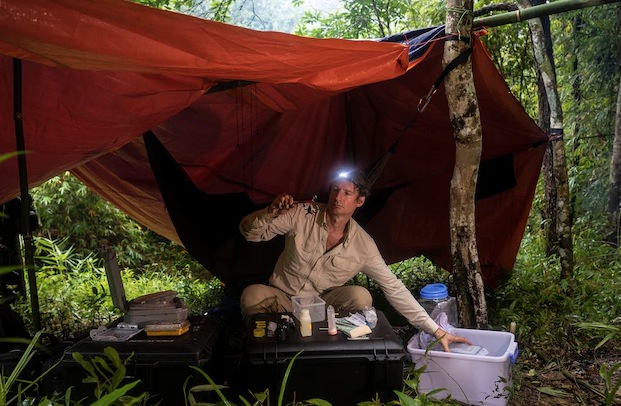Πηγή: Nationalgeographic.com
Μπορούν άραγε να παραχθούν νέα φάρμακα και θεραπείες κατά των ασθενειών, χρησιμοποιώντας ως συστατικό τα… δηλητήρια του φυσικού περιβάλλοντος;
Μέσα από τις τοξικές ουσίες που παράγει η φύση, οι επιστήμονες προσπαθούν να μάθουν τον τρόπο με τον οποίο λειτουργούν τα μοριακά συστατικά τους και αν αυτό μπορεί να ανοίξει τον δρόμο για δημιουργία νέων παυσίπονων και θεραπειών.
Ο Sam Robinson, ερευνητής στο Ινστιτούτο Μοριακής Βιοεπιστήμης στο Πανεπιστήμιο του Κουίνσλαντ της Αυστραλίας, είχε την πρώτη του επαφή με το «γιγαντιαίο τσίμπημα», ή αλλιώς το φυτό Dendrocnide excelsa, κατά τη διάρκεια πεζοπορίας στο δάσος το 2018.
Άγγιξε την επιφάνεια του δέντρου με το αριστερό του χέρι, ώστε να «ελέγξει» αν πρόκειται για ένα όντως τρομακτικό τσίμπημα.
«Αποδείχθηκε ότι τελικά ήταν τόσο άσχημα όσο έλεγαν όλοι », είπε γελώντας, προσθέτοντας ότι «ήταν πραγματικά συγκλονιστικό να βιώνω αυτό το επίπεδο πόνου από ένα φυτό».
Μάλιστα, ο πόνος μεταφέρθηκε και στην αριστερή πλευρά του στήθους του.
Σαν να μην έφτανε η πρώτη εμπειρία, λίγους μήνες αργότερα, άγγιξε ξανά το δέντρο, αυτή τη φορά με το δεξί του χέρι.
Αυτή τη φορά, το τσίμπημα επηρέασε μόνο τη δεξιά πλευρά του στήθους του, υποδηλώνοντας πως ο πόνος αφορούσε ειδικά τα πλευρά.
Σκοπός του Robinson, δεν ήταν απλώς να βιώσει οδυνηρές εμπειρίες μετά τα τσιμπήματα του φυτού και να τις περιγράψει δημοσίως.
Αντιθέτως, αποτελεί μέρος της επιστημονικής κοινότητας που είναι πεπεισμένη ότι υπάρχει ανεκμετάλλευτο ιατρικό υλικό στα δηλητήρια της φύσης.
Χάρη στις τεχνολογικές εξελίξεις της τελευταίας δεκαετίας, υπάρχει πλέον πληθώρα δεδομένων σχετικά με το πώς τα διαφορετικά δηλητήρια επηρεάζουν το σώμα.
Ενώ λοιπόν τα δηλητήρια είναι συνιφασμένα με την πρόκληση βλαβών, η εν λόγω έρευνα δείχνει ότι η χημεία και οι μηχανισμοί του δηλητηρίου θα μπορούσαν να οδηγήσουν σε νέες συναρπαστικές θεραπείες για την αντιμετώπιση του πόνου, τον καρκίνο και άλλες ασθένειες.
Μάλιστα, υπάρχουν ήδη διαθέσιμα φάρμακα σήμερα τα οποία προέρχονται από κάποιο δηλητήριο:
– Ένα από τα πρώτα φάρμακα για την αρτηριακή πίεση που εγκρίθηκαν για κλινική χρήση, το Captoten (καπτοπρίλη), προήλθε από τη μελέτη του δηλητηρίου του Bothrops jararaca, μιας οχιάς, το δάγκωμα της οποίας ρίχνει την αρτηριακή πίεση του θηράματός του.
– Το φάρμακο Byetta (εξενατίδη), το οποίο μειώνει τα επίπεδα γλυκόζης στο αίμα σε ασθενείς με διαβήτη τύπου 2, δημιουργήθηκε από το σάλιο του Gila, μιας δηλητηριώδους σαύρας που κατάγεται από τη Βόρεια Αμερική.
– To δηλητήριο των σαλιγκαριών κώνου ενέπνευσε την ανάπτυξη του Prialt (ζικονοτίδη), ενός παυσίπονου που εγχέεται στο εγκεφαλονωτιαίο υγρό του ασθενούς.
Ωστόσο, ο Robinson και άλλοι ειδικοί υποστηρίζουν ότι χρειάζεται μακράν περισσότερη δουλειά για να μετατραπούν οι χημικές ουσίες δηλητηρίου σε ασφαλή και αποτελεσματικά φάρμακα για τον άνθρωπο.
––––––––––––––––––––––––––––––––––––––––––––––
Sam Robinson had his first excruciating brush with the giant stinging tree during a rainforest hike in 2018. He came across Dendrocnide excelsa in Australia’s Main Range National Park, and he reached for the tree’s hairs with his left hand to see if the sting lived up to its fearsome reputation.
“Turns out, it was as bad as everyone said it was,” he says with a laugh. “It was really shocking to experience that level of pain from a plant.”
The “intense, gripping pain” crept up his left arm and pounded the left side of his chest. A few months later, he touched the same kind of tree again, this time with his right hand, and the twinge hit only the right side of his chest—suggesting the pain was side-specific.
Robinson, a research fellow at the Institute for Molecular Bioscience at the University of Queensland, Australia, doesn’t go looking for painful wilderness encounters just for kicks—although he does chronicle how each sting feels on social media. He is part of a growing cadre of scientists who are convinced there is untapped medical potential in nature’s menu of venoms.
Thanks to technological advances in the past decade, there’s now a wealth of data about how different venoms behave and affect the body. While venoms are mostly famous for causing harm, this research shows that the chemistry and mechanisms of venom could lead to exciting new therapies to treat pain, cancer, and more.
A few proven medications derived from venom are already available for prescription today. One of the first blood pressure drugs approved for clinical use, Captoten (captopril), came from studying the venom of Bothrops jararaca, a pit viper whose bite makes its prey’s blood pressure drop. The drug Byetta (exenatide), which lowers blood glucose levels in patients with type 2 diabetes, was developed from the saliva of the Gila monster, a venomous lizard that’s native to North America. And the venom of cone snails inspired the development of Prialt (ziconotide), a painkiller injected into a patient’s spinal fluid.
But Robinson and others argue that there’s far more work that can be done to turn venom chemicals into safe and effective drugs for humans.
Venom is both “the supervillain and the superhero,” says Mandë Holford, an associate professor of chemistry at Hunter College and City University of New York Graduate Center. Focusing on venomous snails, Holford studies the evolution of venoms with the ultimate goal of deciphering its genetics, or what she calls the “Rosetta Stone of venom.”
“Unless we can understand the language of how venom genes evolve and function,” she says, “then we’re really just sort of tinkering at the surface.”
Venom is both “the supervillain and the superhero,” says Mandë Holford, an associate professor of chemistry at Hunter College and City University of New York Graduate Center. Focusing on venomous snails, Holford studies the evolution of venoms with the ultimate goal of deciphering its genetics, or what she calls the “Rosetta Stone of venom.”
“Unless we can understand the language of how venom genes evolve and function,” she says, “then we’re really just sort of tinkering at the surface.”
Scientists who study venomous creatures commonly get stung as an occupational hazard, and a few of them have set out to document the sensations of some of the world’s most painful envenomations. It’s a hobby with a purpose—rating the pain from a variety of stings allows researchers to compare the distinct sensations, which is one way to determine that components of different venoms interact with the nervous system in different ways.












